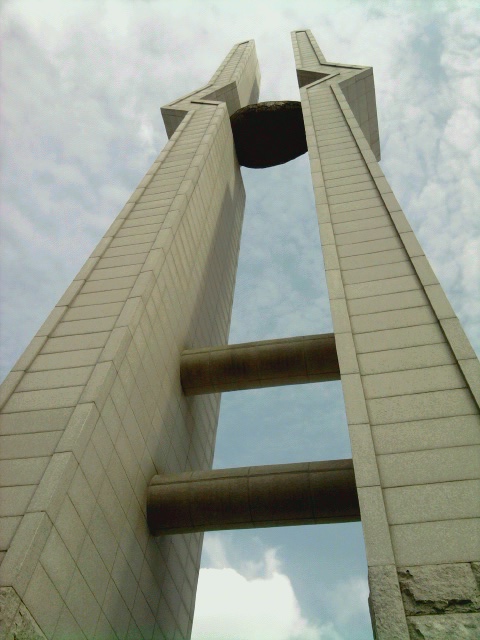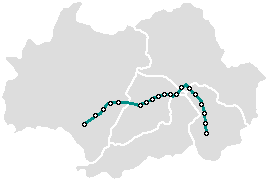|
Sotae Station
Sotae station is a subway station on Gwangju Metro Line 1 in Dong-gu, Gwangju, South Korea. It is named after the Sotae Valley, a large valley of Mudeungsan. Design It encompasses a circuit road that reduces traffic congestion caused by heavy traffic volume entering this area from Hwasun, parking lots, and bike parking lots near the station. It is designed to enhance pedestrian safety by securing 3.5–5 meter-wide sidewalks on both sides of the roads. It is a control station in charge of Hakdong–Jeungsimsa station and Dolgogae station. Station layout See also * Transportation in South Korea Transportation in South Korea is provided by extensive networks of railways, highways, bus routes, ferry services and air routes that traverse the country. South Korea is the third country in the world to operate a maglev train, which is an automa ... References Dong District, Gwangju Gwangju Metro stations Railway stations in South Korea opened in 2004 {{SouthKorea-ra ... [...More Info...] [...Related Items...] OR: [Wikipedia] [Google] [Baidu] |
Gwangju
Gwangju () is South Korea's sixth-largest metropolis. It is a designated metropolitan city under the direct control of the central government's Home Minister. The city was also the capital of South Jeolla Province until the provincial office moved to the southern village of Namak in Muan County in 2005 because Gwangju was promoted to a metropolitan city and was independent of South Jeolla province. Its name is composed of the words ''Gwang'' () meaning "light" and ''Ju'' () meaning "province". Gwangju was historically recorded as ''Muju'' (), in which "Silla merged all of the land to establish the provinces of Gwangju, Ungju, Jeonju, Muju and various counties, plus the southern boundary of Goguryeo and the ancient territories of Silla" in the ''Samguk Sagi.'' In the heart of the agricultural Jeolla region, the city is also famous for its rich and diverse cuisine. History The city was established in 57 BC. It was one of the administrative centers of Baekje during the ... [...More Info...] [...Related Items...] OR: [Wikipedia] [Google] [Baidu] |
South Korea
South Korea, officially the Republic of Korea (ROK), is a country in East Asia, constituting the southern part of the Korea, Korean Peninsula and sharing a Korean Demilitarized Zone, land border with North Korea. Its western border is formed by the Yellow Sea, while its eastern border is defined by the Sea of Japan. South Korea claims to be the sole legitimate government of the entire peninsula and List of islands of South Korea, adjacent islands. It has a Demographics of South Korea, population of 51.75 million, of which roughly half live in the Seoul Capital Area, the List of metropolitan areas by population, fourth most populous metropolitan area in the world. Other major cities include Incheon, Busan, and Daegu. The Korean Peninsula was inhabited as early as the Lower Paleolithic period. Its Gojoseon, first kingdom was noted in Chinese records in the early 7th century BCE. Following the unification of the Three Kingdoms of Korea into Unified Silla, Silla and Balhae in the ... [...More Info...] [...Related Items...] OR: [Wikipedia] [Google] [Baidu] |
Gwangju Metropolitan Rapid Transit Corporation
Gwangju Metro () is the rapid transit system of Gwangju, South Korea, operated by the Gwangju Metropolitan Rapid Transit Corporation (GRTC, or Gwangju Metro). The subway network first opened in 2004 with 14 stations. The Gwangju Metro consists of one line, serving 20 operational stations, and operating on of route. It crosses both of the major rivers in Gwangju, the Yeongsan River and the Hwangryong River. Most of the system is underground, except for the sections between Sotae-Nokdong and Pyeongdong-Dosan. History * Apr 28, 2004 : Line 1 partially opened ( Nokdong ↔ Sangmu ) * Apr 11, 2008 : Line 1 fully opened ( Nokdong ↔ Pyeongdong ) Lines Line 1 As of 2021 Line 1 consists of twenty stations. Most trains run between Pyeongdong and Sotae, with about one train per hour continuing towards Nokdong. Line 2 Line 2 () of the subway is under construction as of 2021. It is scheduled to open in three phases between 2023 and 2025. Expansions and plans Plan to extend Line 1 ... [...More Info...] [...Related Items...] OR: [Wikipedia] [Google] [Baidu] |
Gwangju Metro Line 1
Gwangju Metro Line 1 is a rapid transit line in Gwangju, South Korea, operated by the Gwangju Metropolitan Rapid Transit Corporation (GRTC, or Gwangju Metro). It connects Nokdong station in Dong-gu at its eastern terminus to Pyeongdong station in Gwangsan-gu in the west, via the central business district and Gwangju Airport. On maps, it is designated by teal (). The line began operations in 2004, making Gwangju the fifth South Korean city with a rapid transit system. History * August 28, 1996: Ground breaking ceremony for the Line 1 * April 28, 2004: Line 1 partially opened (Nokdong ↔ Sangmu) * April 11, 2008: Line 1 fully opened (Nokdong ↔ Pyeongdong) Stations As of 2021 Line 1 consists of twenty stations. Most trains operate between Pyeongdong and Sotae, with about one service per hour continuing to Nokdong station. Plan to extend Line 1 The Gwangju City Government has a plan to extend the current Line 1 southward to Hwasun and northward to Naju. Recently, the Preside ... [...More Info...] [...Related Items...] OR: [Wikipedia] [Google] [Baidu] |
Dong-gu, Gwangju
Dong District (Dong-gu) is a district, similar to a ward, situated in the city of Gwangju, South Korea. Mt. Mudeung is a famous landmark in the district. Modern art Art is a diverse range of human activity, and resulting product, that involves creative or imaginative talent expressive of technical proficiency, beauty, emotional power, or conceptual ideas. There is no generally agreed definition of wha ... is displayed at the Street of Art, which was the first one of its kind in South Korea. It has Asian Cultural Center and Gwangju International Community Center. See also * Hwanggeum-dong, Gwangju External linksWebsite of Dong-gu, Gwangju {{SouthKorea-geo-stub ... [...More Info...] [...Related Items...] OR: [Wikipedia] [Google] [Baidu] |
Mudeungsan
Mudeungsan () is a mountain in South Korea. It extends over the district of Buk-gu in the city of Gwangju, as well as Hwasun County and Damyang County in the province of Jeollanam-do. Mudeungsan has an elevation of and is a part of Mudeungsan National Park which gained national park status in 2012. The peak of Mudeungsan is named Cheonwang summit, but it has been designated as a protection zone for air force military installations. Therefore the highest spot the climbers can ascend without special permission is Seoseokdae Rock, with an elevation of . Looking from the summit, Hallasan in Jeju Island and Geojedo in Namhae, Gyeongsangnam-do can be seen. Name The mountain was known as Muak or Mujinak due to its location Mujinju, the former name of Gwangju. As most of the big mountain ranges are related to shamanism, it was also called "the Grave Mountain" or "the Shaman Mountain". The Mudeungsan range is primarily composed of soil rather than rocks. It was called Seoseok mounta ... [...More Info...] [...Related Items...] OR: [Wikipedia] [Google] [Baidu] |
Hwasun
Hwasun County (화순군; ''Hwasun-gun'') is a county in South Jeolla Province, South Korea. Symbol * County Flower : Wild Chrysanthemum * County Tree : Zelkova ''Zelkova'' (from Georgian ''dzelkva'', 'stone pillar') is a genus of six species of deciduous trees in the elm family Ulmaceae, native to southern Europe, and southwest and eastern Asia. They vary in size from shrubs (''Z. sicula'') to large ... Tree * County Bird : Dove History Before Hwasun became an administrative community in the Japanese Empire, individual culture was formed along three rivers: Jiseokcheon River to Neungju, Hwasuncheon River to Hwasun, and Dongbokcheon River to Dongbok. Recently relics in the Stone Age (residential remains) and in the Middle Stone Age were found in Juam Dam at Daejeon Village, Sasu-ri, Nam-myeon, showing that people lived from old times. Bronze Age remains include 1,180 dolmens and a variety of remains excavated in a stone-lines tomb at Daegok-ri (including National Trestur ... [...More Info...] [...Related Items...] OR: [Wikipedia] [Google] [Baidu] |
Hakdong–Jeungsimsa Station
Hakdong·Jeungsimsa station () is a station on Line 1 of the Gwangju Metro in Hak-dong, Gwangju, South Korea. It opened on April 28, 2004. Name origin Jeungsimsa is situated in Hakdong. Hakdong was originally called Hakmaeul ("crane village") as it is a hill area on the Mudeung Mountain that looks like a crane. Since 1947, Hakmaeul has been renamed Hakdong·Jeungsimsa. Features Its simple image with simple decoration gives a familiar and comfortable impression. Various signs and billboards act as background scenery. The consistent use of materials and decorative patterns gives a simple and neat image. Surrounding area Nammunno is the axis that connects the downtown-bound and Hwasunn-bound planning line. In the west are neighborhood market facilities and in the east are high-rise apartments and greenery. Station layout See also * Gwangju Metro * Transportation in South Korea Transportation in South Korea is provided by extensive networks of railways, highways, bus routes, fer ... [...More Info...] [...Related Items...] OR: [Wikipedia] [Google] [Baidu] |
Dolgogae Station
Dolgogae station () is a station of Gwangju Metro Line 1 in Wolsan-dong, Nam District, Gwangju, Nam District, Gwangju, South Korea. Station layout Exits External links *Cyber station informationfrom Gwangju Metro, Gwangju Metropolitan Rapid Transit Corporation *Cyber station information from Gwangju Metro, Gwangju Metropolitan Rapid Transit Corporation Gwangju Metro stations Buk District, Gwangju Railway stations in South Korea opened in 2004 {{SouthKorea-railstation-stub ... [...More Info...] [...Related Items...] OR: [Wikipedia] [Google] [Baidu] |
Side Platform
A side platform (also known as a marginal platform or a single-face platform) is a railway platform, platform positioned to the side of one or more railway tracks or guideways at a railway station, tram stop, or bus rapid transit, transitway. A station having dual side platforms, one for each direction of travel, is the basic design used for double-track railway lines (as opposed to, for instance, the island platform where a single platform lies between the tracks). Side platforms may result in a wider overall footprint for the station compared with an island platform where a single width of platform can be shared by riders using either track. In some stations, the two side platforms are connected by a footbridge running above and over the tracks. While a pair of side platforms is often provided on a dual-track line, a single side platform is usually sufficient for a single-track line. Layout Where the station is close to a level crossing (grade crossing) the platforms may ei ... [...More Info...] [...Related Items...] OR: [Wikipedia] [Google] [Baidu] |
Nokdong Station
Nokdong station is a railway station on Gwangju Metro Line 1 in Nokdong, South Korea South Korea, officially the Republic of Korea (ROK), is a country in East Asia, constituting the southern part of the Korea, Korean Peninsula and sharing a Korean Demilitarized Zone, land border with North Korea. Its western border is formed .... The station is located near at the depot. Station layout Gallery File:Gwangju-metro-100-Nokdong-station-sign-20190522-061056.jpg File:Gwangju-metro-100-Nokdong-station-platform-20190522-061730.jpg File:Gwangju-metro-100-Nokdong-station-building-20190522-061848.jpg External links Gwangju Metro stations Railway stations opened in 2004 Dong District, Gwangju {{SouthKorea-railstation-stub ... [...More Info...] [...Related Items...] OR: [Wikipedia] [Google] [Baidu] |


